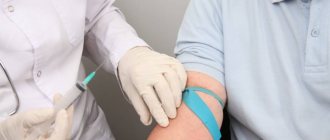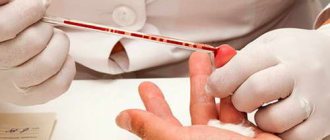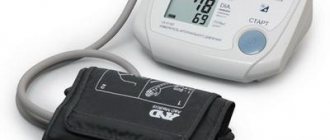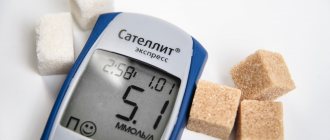Lipid profile, screening
Reference values
| Index | Normal values | ||
| Total cholesterol (TC) | Age < 5 years 5–10 years 10–15 years 15–18 years | Men 2.95–5.25 3.13–5.25 3.08–5.23 2.93–5.10 | Women 2.90–5.18 2.26–5.30 3.21–5.20 3.08–5.18 |
| Triglycerides (TG) | Age < 10 years 10–15 years 15–18 years | Men 0.34–1.13 0.36–1.41 0.45–1.81 | Women 0.40–1.24 0.42–1.48 0.40–1.53 |
| High-density lipoproteins (HDL, HDL-C) | Age 5–10 years 10–15 years 15–18 years | Men 0.98–1.94 0.96–1.91 0.78–1.63 | Women 0.93–1.89 0.96–1.81 0.91–1.91 |
| Low-density lipoproteins (LDL, LDL-C) |
| ||
| Age 5–10 years 10–15 years 15–18 years | Men 1.63–3.34 1.66–3.44 1.61–3.37 | Women 1.76–3.63 1.76–3.52 1.53–3.55 | |
| Very low density lipoproteins (VLDL, VLDL-C) | <0.8 mmol/l | ||
| Non-high-density lipoprotein (non-HDL) cholesterol | desired level < 3.8 mmol/l | ||
For people over 18 years of age, normal cholesterol levels are less than 5.0 mmol/L.
However, this number is arbitrary, since the doctor must take into account other indicators of the lipid spectrum (LDL and triglyceride levels will be important). Decoding indicators
The result of a lipid spectrum study should be interpreted depending on the purpose of the examination and the specific clinical situation, in conjunction with the data of a medical examination and the results of other studies.
Total cholesterol
– an indicator reflecting the totality of all cholesterol fractions circulating in the blood.
Cholesterol itself is insoluble in the blood. To transport cholesterol in the body, complex compounds are formed by binding to protein molecules. Such complexes are called lipoproteins
.
Depending on the particle size and their functions, high-density lipoproteins (HDL, HDL-C), low-density lipoproteins (LDL, LDL-C), very low-density lipoproteins (VLDL, VLDL-C), cholesterol not associated with high-density lipoproteins are isolated density (non-HDL), and a number of other substances.
Why is cholesterol needed in the body? Cholesterol is formed in the liver, intestines and skin, and also comes from food of animal origin. It is impossible to completely avoid consuming cholesterol in food for a number of reasons. Firstly, it is one of the main building materials for all cells. Secondly, cholesterol is actively involved in the formation of various hormones, including sex hormones. Cholesterol is also important for the digestion process - it is involved in the formation of bile in the liver. Cholesterol is a precursor to vitamins D, which, in particular, help strengthen bones.
High density lipoproteins (HDL)
- the only fraction of cholesterol that is called “good”, “healthy” cholesterol. HDL significantly reduces the risk of developing atherosclerosis. These molecules remove excess “bad” cholesterol from the body by transporting it from the tissues to the liver, where the cholesterol is converted into bile acids and then released into the intestines.
If the HDL result is below reference values, the risk of developing atherosclerosis and serious cardiovascular pathology increases significantly. Also, low levels of HDL can be observed in the following conditions: familial dyslipidemia, chronic liver diseases with symptoms of bile stagnation (cholestasis), chronic kidney disease, diabetes mellitus, obesity, long-term use of certain medications (beta blockers, diuretics, progestins, androgens). A diet rich in simple carbohydrates or saturated fatty acids also helps lower HDL levels.
Low-density lipoproteins (LDL)
are considered a “harmful”, “atherogenic” fraction of cholesterol, that is, they provoke the development of atherosclerosis. With this disease, the risk of developing life-threatening conditions such as stroke, acute myocardial infarction, coronary heart disease, and heart failure increases significantly.
A decrease in LDL cholesterol does not play a significant role in the diagnosis of diseases. A significant decrease in the level of LDL in the blood is possible with severe liver diseases, cancer, infections, burns, hyperthyroidism, and malnutrition.
Very low density lipoproteins (VLDL)
also belong to the “bad” fraction of cholesterol, since they serve as the main precursors of LDL. VLDL transports fats from the liver to body tissues and actively participates in the formation of atherosclerotic plaques. In people with diabetes, VLDL accelerates the development of atherosclerosis.
VLDL and LDL can increase in many diseases: obesity, diabetes mellitus, chronic kidney disease, hypothyroidism, chronic pancreatitis, systemic lupus erythematosus, hereditary disorders of fat metabolism, pregnancy, alcohol abuse.
A decrease in VLDL concentration has no diagnostic value.
Intermediate density lipoproteins (IDL)
– a transitional form between HDL and LDL, part of the group of atherogenic (“harmful”) cholesterol fraction. The study is used in conjunction with other lipid profile indicators to assess the risk of developing atherosclerosis.
Lipoprotein (a) (LP(a))
- a molecule similar to LDL, also classified as atherogenic and having a protein component. The study of Lp(a) is carried out when treatment for dyslipidemia is ineffective and is a genetic risk factor for the development of cardiovascular diseases, regardless of the level of other atherogenic fractions of cholesterol.
Cholesterol not bound to high-density lipoprotein
(non-HDL), is the sum of all atherogenic cholesterol fractions (LDL + VLDL + LDLP + LP(a)). This indicator allows for better control of treatment for mild to moderate increases in triglyceride levels, since in such a situation the measurement and calculation of LDL is less accurate.
Triglycerides
They are one of the main sources of energy in the body. They come from food and are formed in the intestines, liver and adipose tissue. With an excess intake of calories and a sedentary lifestyle, adipose tissue deposits triglycerides as an energy source.
Transport of triglycerides in the body is carried out using protein complexes, mainly in the form of very low density lipoproteins (VLDL).
An increase in the level of triglycerides in the blood plasma often occurs when the principles of a healthy diet are violated, with obesity, alcohol abuse, diabetes mellitus, various kidney diseases, and liver diseases. In rare cases, an increase in triglyceride levels may be a consequence of hereditary disorders of lipid metabolism (in such situations, the study results exceed the upper limit of values tens of times). Along with this, an increase in the concentration of triglycerides, like other types of fats in the blood, leads to an increased risk of developing cardiovascular diseases.
Reduced triglyceride levels are not significant in diagnosis. It is most often found in intestinal pathologies associated with malabsorption of nutrients, during a period of strict diet, fasting, and hyperthyroidism.
Atherogenic index
– the ratio of non-HDL cholesterol to HDL cholesterol. This indicator is calculated in a laboratory or by a doctor to assess the risk of cardiovascular disease. An increase in the atherogenic index indicates an increased risk of pathology.
For additional diagnosis of atherosclerotic changes and damage to internal organs, use:
- Biochemical blood test - indicators of liver function: total protein, albumin, alanine aminotransferase (ALAT), aspartate aminotransferase (AST), bilirubin and its fractions.
Lipid profile indicators. How to take the test correctly and what affects the result?
Laboratory diagnostics doctor of the clinical diagnostic laboratory Kapustina E.V.
When going for any research or analysis, we all want to get the correct and most reliable result, and in the case of a lipidogram , as with other analyses, you need to know and follow some rules so as not to distort the indicators.
The blood lipid spectrum is very sensitive to external conditions. This doesn't just apply to food intake. The results can be affected by anxiety, excessive exercise, taking medications, having recently had other tests, drinking alcohol the night before the test, infections, etc., so all these factors need to be kept in mind.
It is recommended to take blood samples for lipid levels in the morning, on an empty stomach, at least 12-14 hours after the last meal. Half an hour before the test, you should exclude physical activity and psycho-emotional experiences, as well as smoking.
Before drawing blood, you must maintain your normal diet for 2 weeks.
Key lipid profile indicators:
- Total cholesterol (TC)
- Triglycerides (neutral fat) (TG)
- High-density lipoprotein cholesterol (HDL-cholesterol, or HDL-cholesterol)
- Low-density lipoprotein cholesterol (LDL-cholesterol, or LDL-cholesterol)
- Very low density lipoprotein cholesterol (VLDL-C)
- Atherogenic coefficient (AC)
- Apolipoproteins (apo-A, apo-B)
How to decipher the analysis?
Many people know that cholesterol is the most important indicator of fat metabolism, so its increase is always a cause for concern. However, this indicator alone is not enough for correct conclusions, because cholesterol can increase in absolutely healthy individuals without provoking atherosclerosis. At the same time, normal and low cholesterol levels do not always indicate well-being. To assess fat metabolism, it is important to establish the ratio of individual lipid fractions, the fluctuations of which are more characteristic of pathology or normality.
Cholesterol “travels” through blood vessels not alone, but in combination with proteins, forming globules (balls) of different sizes and densities, which are called lipoproteins . The proteins found in lipoproteins are called apolipoproteins . The more protein a lipoprotein contains, the higher its density. Hence, high-density lipoproteins (HDL), intermediate-density lipoproteins (LDL), low-density lipoproteins (LDL), and very low-density lipoproteins (VLDL), as well as chylomicrons (CM) are isolated. Chylomicrons are formed in the intestinal wall, they transport neutral fat (triglycerides) obtained from food. Cholesterol and lipoproteins are formed in the liver and perform different tasks.
Cholesterol is an integral component of cell membranes; it is part of bile, necessary for proper digestion, and is a precursor of sex hormones, without which development, puberty and functioning of the adult body do not occur.
But on the other hand, cholesterol can cause various troubles:
One of the main negative features of cholesterol is its direct participation in the formation of atherosclerotic plaques on the walls of arterial vessels. This “task” is performed by the so-called atherogenic cholesterols in low and very low density lipoproteins (LDL and VLDL), which account for 2/3 of the total amount of cholesterol in the blood plasma. They are endowed with the ability to “stick” to the walls of blood vessels and participate in the formation of cholesterol plaque with subsequent narrowing of the lumen of the vessel. True, anti-atherogenic high-density lipoproteins (HDL), which protect the vascular wall, try to counteract “bad” cholesterol, but there are 2 times less of them (1/3 of the total).
The level of cholesterol in the blood should not exceed 5.2 mmol/l, however, even a concentration value approaching 5.0 cannot give complete confidence that everything is fine in a person, since the content of total cholesterol is not an absolutely reliable sign of well-being. Therefore, it is important to determine the ratio of atherogenic (VLDL and LDL) and antiatherogenic (HDL) lipoproteins, which more subtly reflects the state of lipid metabolism and the course of atherosclerosis.
Low-density lipoprotein cholesterol (LDL-cholesterol, or LDL-cholesterol) in a healthy person makes up 60-65% of the total and does not exceed 3.5 mmol/l. In those who have already been affected by atherosclerosis, LDL-C values may increase markedly, that is, this indicator is more informative regarding atherosclerosis than the level of total cholesterol in the blood.
Normally, high-density lipoprotein cholesterol (HDL cholesterol or HDL cholesterol) in women should be greater than 1.2 mmol/l (in men the lower limit is different – 1.0 mmol/l). If the level of HDL cholesterol becomes less than acceptable values, they cannot fully protect the blood vessels. The number of HDL particles increases with exercise in the fresh air.
Triglycerides are important as a source of energy. They are carried in very low density lipoproteins and chylomicrons. Their number increases sharply after eating fatty foods.
It has been established that TGs increase with atherosclerosis, diabetes mellitus, excess weight, hypertension and play an important role in the development of coronary heart disease and vascular changes in the brain.
An indicator such as atherogenicity coefficient , which indicates the degree of development of the atherosclerotic process, but is not the main diagnostic criterion, is calculated mathematically using special formulas; its normal values range from 2-3.
The atherogenicity coefficient can also serve as a prognostic indicator. If it is below three, then the risk of atherosclerosis and vascular lesions is minimized. A coefficient level of 3-4 may indicate an increased risk of atherosclerosis, and with a value of 5 or higher, patients usually already have certain manifestations of atherosclerosis - coronary heart disease, cerebrovascular accident, kidney pathology, impaired blood flow in the extremities. With such numbers, vascular complications are quite likely.
Apolipoproteins are relatively new, modern indicators of lipid metabolism; they complement the main indicators of the lipid profile. ApoB is found in low-density lipoproteins and increases the atherogenic properties of the blood. ApoA is associated with high-density lipoproteins and increases their antiatherogenicity.
When deciphering a lipid profile in adults, the doctor assesses whether there are deviations in the numbers of specific indicators. It is believed that the risk of atherosclerosis is increased if total cholesterol, LDL-C, VLDL-C, apoB and TG exceed normal values. Pathology is also indicated by an atherogenic coefficient of more than three and a reduced content of high-density lipoproteins (HDL-C) and apoA.
In addition, low cholesterol levels are just as undesirable as high ones (if this is not associated with taking lipid-lowering drugs); it may indicate various pathologies: anemia, liver disease, increased thyroid function and even cancer.
The values of lipid spectrum indicators are considered optimal:
Total cholesterol – 3.1-5.2 mmol/l
Triglycerides up to 1.7 mmol/l;
HDL cholesterol – 1.03-1.55 mmol/l
LDL cholesterol - 2.32 -3.5 mmol/l
Atherogenic coefficient – 2 -3.0;
If a person is diagnosed with hypercholesterolemia (increased cholesterol levels), then it is customary to assess its degree:
- cholesterol level 5.2-6.2 mmol/l is considered borderline high
- 6.2-7.5 mmol/l – moderate hypercholesterolemia
- >7.8 mmol/l - severe hypercholesterolemia
Every adult over 20 years of age should know their cholesterol level and regularly, at least once a year, it is recommended to determine total cholesterol, and every 5 years to perform a complete study of the lipid spectrum
Some reasons for high cholesterol levels:
- poor nutrition;
- sedentary lifestyle;
- obesity;
- smoking,
- alcohol abuse;
- diabetes;
- arterial hypertension;
- liver diseases;
- hypothyroidism;
- hereditary disorder of lipid metabolism.
Decoding the result:
1). Cholesterol is the most important indicator of lipid metabolism.
80% of cholesterol is formed in the body itself in the liver, intestines, kidneys, adrenal glands, gonads, and only 20% comes from food from the outside with products of animal origin (eggs, butter, meat). The level of cholesterol in the blood largely depends on age and gender.
Cholesterol is ABOVE normal:
- hereditary lipoproteinemia - liver diseases - glomerulonephritis, chronic renal failure - hypothyroidism - gout - diabetes - pregnancy - coronary heart disease - malignant diseases of the pancreas and prostate - foods rich in cholesterol and unsaturated fatty acids - taking certain medications such as androgens , diuretics, etc.
Cholesterol is BELOW normal:
- cachexia, fasting - burns - malabsorption in the intestine - severe acute diseases and infections - sepsis - hyperthyroidism - hypolipoproteinemia - mental retardation - taking medications that lower cholesterol - low cholesterol foods
2) Triglycerides are the main lipids in the blood that provide energy to cells.
Mainly supplied with food, and slightly synthesized in the liver and intestines.
Triglycerides ABOVE normal:
- primary hypertriglyceridemia (familial according to different phenotypes) - coronary heart disease, myocardial infarction, angina pectoris, atherosclerosis - obesity - viral hepatitis and cirrhosis - diabetes mellitus - hypothyroidism - acute or chronic pancreatitis - pregnancy - thalassemia
Triglycerides BELOW normal: - hypolipoproteinemia - hyperthyroidism-hyperparathyroidism - malnutrition - malabsorption syndrome (malabsorption in the intestine) - chronic lung diseases - taking heparin, vitamin C, progestins
3). Cholesterol - HDL - high-density lipoproteins or "good" cholesterol - are lipoproteins that carry cholesterol from the peripheral blood to the liver. Women have higher HDL levels than men.
4). Cholesterol - LDL - low-density lipoproteins or “bad” cholesterol LDL transports lipids, including cholesterol, from one cell to another. An LDL level of more than 3.37 mmol/l indicates a factor in the development of atherosclerosis, and more than 4.14 indicates a high risk of developing atherosclerosis and coronary heart disease.
5). VLDL - very low density lipoproteins - a marker of atherogenicity. Transports exogenous lipids in plasma. They transport triglycerides from the liver to peripheral vessels.
Based on these 5 indicators of the lipid spectrum, the ATHEROGENIC INDEX is calculated - this is the risk of developing atherosclerosis!
The norm for a healthy person is 3-3.5. If AI is higher than normal, then “bad” cholesterol predominates in the body.
Dear friends! Now you know everything about such an important and simple analysis - a lipid profile!
4.Preparation and analysis
To obtain objective results from a lipid profile test, special preparation
. Blood is drawn only in the morning on an empty stomach. The last meal before this can be no later than 12 hours. You can only drink water. It is recommended not to smoke for at least 2 hours before donating blood. The day before the test, you should avoid drinking alcohol. Physical activity and stressful situations on the day before the lipid profile study are undesirable.
Blood for analysis is taken from a vein and sent to a biochemical laboratory. This study has no contraindications or any side effects. Moreover, its importance is great not only in terms of treating an already manifested disease, but also for the prevention of cardiovascular diseases, which often develop gradually, almost unnoticeably. All adults are recommended to undergo lipid profile testing from time to time.
PRINCIPLES OF TREATING lipid metabolism disorders
I. A. Libov, Candidate of Medical Sciences D. A. Itkin S. V. Cherkesova
RMAPO, Moscow
The need to correct lipid metabolism disorders is currently beyond doubt. Numerous studies conducted before the beginning of the 90s have proven the possibility of reducing cholesterol (CH), triglycerides (TG) and normalizing lipid metabolism parameters against the background of cholesterol-lowering therapy.
But does a pronounced decrease in total cholesterol (TC) and low-density lipoprotein cholesterol (LDL-C) always improve life prognosis?
The CARE study showed that reducing LDL-C below 3.2 mmol/L did not lead to a further reduction in mortality. At the same time, according to the POST-CABGT study, which included patients after coronary artery bypass surgery (CABG), when LDL cholesterol was reduced to a level of less than 2.6 mmol/l (compared to patients with a level of 3.4-3.5 mmol /l) the need for repeat CABG operations is reduced by 29%. Similar results were obtained in the CARS study, which included patients with coronary artery disease, a relatively normal level of TC (from 4.1 to 5.6 mmol/l) and an average level of LDL-C (3.17 mmol/l). Currently, European cardiologists consider achieving an LDL cholesterol level of less than 3.0 mmol/l as the goal of cholesterol-lowering therapy for secondary prevention of coronary artery disease, and American cardiologists consider it to be less than 2.6 mmol/l.
The effectiveness of both drug and non-drug methods for correcting the level of dyslipidemia has been shown. Moreover, any correction should begin with the elimination of risk factors that contribute to the progression of atherosclerosis, such as smoking, physical inactivity, as well as with the normalization of body mass index.
In cases of dyslipidemia occurring against the background of diseases such as hypothyroidism, nephrotic syndrome, etc., it is necessary first of all to begin treatment of the underlying disease.
| Drawing. Normalizing the level of lipoproteins in the blood reduces the need for surgical treatment |
One of the main methods of non-drug treatment is following a diet with limited consumption of animal fats and easily digestible carbohydrates, and limiting caloric intake. In the Veterans Administrations study, patients were prescribed a diet higher in polyunsaturated fatty acids and lower in animal fat (compared to patients on a standard North American diet). Diet therapy for eight years led to a decrease in TC levels by 12.7% and a decrease in the incidence of myocardial infarction (MI) by 20%. However, there was no decrease in overall mortality in any of the groups of patients. In the Finnish Mental Hospital Study, over a six-year observation period in 450 patients of both sexes aged 34-64 years, a low cholesterol diet showed a 15% decrease in cholesterol levels in the blood. At the same time, achieving an average TC level of 5.8 mmol/l did not cause a significant reduction in overall mortality or mortality from cardiovascular diseases. In the DART study, which included more than 2,000 patients with a mean age of 56.5 years, adherence to the diet for two years resulted in a non-significant reduction in overall mortality and mortality from coronary artery disease. However, ischemic events (non-fatal MI) were even more common in the group of patients on the diet. The largest study, the Minnesota Coronary Survey, included approximately 5,000 patients of both sexes and all ages with an average baseline TC level of 5.3 mmol/L, and found that following a cholesterol-lowering diet alone resulted in a 14.5% reduction in TC levels over 4.5 years. compared to a control group following a standard diet. This study also did not show a reduction in cardiovascular disease or overall mortality.
In our opinion, treatment of patients with hypercholesterolemia and hypertriglyceridemia must in all cases begin with the elimination of risk factors and the appointment of a hypocholesterolemic diet. Moreover, if the diet is effective, then it can be considered as monotherapy only if the patient is truly able to follow the diet for the rest of his life. However, in patients with coronary artery disease during an exacerbation of the disease and in the presence of severe hypercholesterolemia, along with diet, simultaneous administration of cholesterol-lowering drugs in adequate doses is recommended. Normalizing the level of lipid metabolism indicators only on the background of diet in such patients is not possible, and untimely initiation of treatment can lead to the development of adverse complications.
In the absence of an “acute” situation, the failure of non-drug therapy for three months is an indication for drug therapy. It should be noted that the use of lipid-lowering drugs, no matter what class they belong to, in no case means a refusal to follow a diet. On the contrary, any cholesterol-lowering therapy will be effective if you follow a diet.
Currently, there are five main classes of drugs used, taking into account their mechanism of action, effectiveness and side effects, as well as contraindications for a particular type of dyslipidemia.
I Statins. II Nicotinic acid and its derivatives. III Fibrates. IV Bile acid sequestrants. V Antioxidants.
To date, the effect on overall mortality, mortality from cardiovascular diseases and the risk of developing cardiovascular complications has been proven only for drugs from the statin group. The action of these drugs is based on inhibition of the enzyme 3-hydroxy-3-methylglutaryl-coenzyme-A (HMG-co-A) reductase. By inhibiting cholesterol biosynthesis in the liver and intestines, statins reduce intracellular cholesterol reserves. This causes the formation of an increased number of receptors for LDL and accelerates their removal from the plasma.
Other mechanisms of action of statins on vascular endothelium and platelet aggregation have not been fully studied.
The effect of statins is primarily aimed at reducing LDL cholesterol and total cholesterol. Recent work has shown that the use of high doses of statins can significantly reduce triglyceride levels and compete with the effect of fibrates.
To date, the following drugs from the statin group are registered in Russia:
- lovastatin (Mevacor, Merck Sharp & Dohme)
- simvastatin (Zocor, same company)
- pravastatin (lipostat, Bristol Mayer Scweeb)
- fluvastatin (lescol, Novartis)
- Atorvastatin (Liprimar, Pfizer)
- cerivastatin (lipobay, Bayer)
According to WC Roberts (1997), a 10 mg dose of simvastatin is approximately equivalent to 20 mg of lovastatin or pravastatin and 40 mg of fluvastatin. According to his studies, doubling the statin dose relative to the initial dose leads to an additional reduction in TC by approximately 5% and LDL-C by 7%. However, the increase in high-density lipoprotein cholesterol (HDL-C) levels does not depend on increasing the dose of the drug.
Drugs from the statin group are used for primary and secondary prevention of coronary artery disease. Secondary prevention refers to the use of drugs in patients with proven coronary artery disease.
It seems to us that the greatest effectiveness when prescribing statins should be determined not only by the level of initial indicators of lipid metabolism, but also by a combination of the total risk of developing cardiovascular complications and the clinical course of the disease. Thus, in patients with acute coronary syndrome, the clinical effect of statins may be more pronounced than in patients with stable angina, and tactics should be more aggressive. However, these conclusions are based on our practical experience; they have not yet been confirmed in multicenter randomized studies.
Statins, like aspirin and β-blockers, are drugs that affect the prognosis of the disease in patients with coronary artery disease.
The effectiveness of statins has also been proven in studies on primary prevention.
Studies 4S, CARE, LIPID, WOSCOPS, AFCAPS/TEXCAPS and others demonstrate the effectiveness of statin therapy for secondary and primary prevention of coronary artery disease. At the same time, the effect of statins on “endpoints” in secondary prevention is more pronounced and more economically justified. Therefore, the use of statins in patients with diagnosed coronary artery disease in combination with dyslipidemia can be recommended to all patients. The effectiveness of statin therapy is higher in the group of patients with more severe lipid metabolism disorders. The development of “coronary events” in a number of patients with coronary artery disease against the background of normal values of lipid metabolism indicates the multifactorial nature of the genesis of these complications and emphasizes the importance of not only the level of dyslipidemia, but also a combination of a number of factors, the most important of which are the clinical manifestations of exacerbation of the disease.
One of the possible reasons for the effectiveness of cholesterol-lowering drugs in the prevention of coronary artery disease is their ability to slow down the progression and even the possibility of regression of the atherosclerotic process, demonstrated in a number of studies. These effects were studied by measuring vessel diameter using arteriography or intravascular ultrasound.
In the MAAS study in patients with coronary artery disease, treatment with simvastatin at a dose of 20 mg for four years revealed a statistically significant reduction in the development of new coronary artery stenoses and regression of existing coronary stenoses; The lumen of the vessels increased from 0.06 to 0.17 mm in the presence of an initial stenosis of more than 50%.
Slowing the progression or regression of atherosclerosis is achieved through intensive and aggressive cholesterol-lowering therapy with a significant reduction in LDL-C levels. Simvastatin and atorvastatin have the greatest hypocholesterolemic activity in the same dosage. In the SMAC study, the use of atorvastatin and simvastatin at a dose of 10-20 mg per day allowed almost 50% of patients with coronary artery disease and an initial LDL-C level of 4.2 to 7.8 mmol/l to achieve the target level after 52 weeks of treatment. At the same time, the effect of atorvastatin occurred somewhat faster, and after 16 weeks of treatment it was achieved in 46% of patients compared to 27% during treatment with simvastatin. By the end of the year, this difference leveled out, amounting to 50% during treatment with atorvastatin and 48% during treatment with simvastatin, and was statistically insignificant. This study showed a pronounced hypocholesterolemic effectiveness of both statins and approximately the same effect after a year of treatment with both drugs. However, in most European countries the cost of simvastatin was slightly lower than that of atorvastatin. In this study, no serious side effects requiring drug discontinuation were observed.
Another important lipid-lowering agent used to normalize lipid metabolism is nicotinic acid and its derivatives (niacin). According to V. Parson, the advantage of this group of drugs is that “they do everything as it should.” Along with reducing the level of TC and LDL-C, drugs in this group reduce triglyceride levels and are more successful than any other lipid-lowering drugs in increasing the level of HDL-C. These drugs also have a number of other advantages. For example, they reduce the level of lipoprotein "a", which is given great importance as an important independent risk factor for the development of complications such as heart attack and stroke. Nicotinic acid preparations and its derivatives reduce LDL levels, acting primarily on their small, most atherogenic particles. These drugs increase HDL-C levels at the expense of the HDL2 fraction, which is the most active in removing lipids from plaques, and thereby prevent the progression of atherosclerosis.
A number of studies have shown the possibility of reducing cardiovascular complications and overall mortality with the use of niacin.
The US Cardiovascular Drug Program compared a number of cholesterol-modifying drugs. The study was conducted in men 30-65 years old who had a history of at least one heart attack. The effects of estrogens, thyroxine, clofibrate and niacin were studied. Each group consisted of approximately 1,100 patients, and the placebo group was twice as large. The expected duration of the study was 5 years, but for the first two drugs it was stopped early due to the development of a large number of heart attacks and other complications. Clofibrate did not have a beneficial effect on mortality or cardiovascular events. Thus, nicotinic acid was the only drug that was able to reduce the number of non-fatal heart attacks by approximately 27%, strokes by 24%, the number of hospitalizations for cardiovascular complications by 12%, and the need for surgical treatment of the heart and blood vessels. by 46%.
The trend towards a decrease in mortality, observed over 5 years of observation while taking niacin, turned out to be statistically insignificant.
An important advantage of this group of drugs is their relatively low cost compared to other lipid-lowering drugs. Currently, slow-release forms of niacin are most often used. They provide a longer and more gradual release of the active compound and cause a significant reduction in side effects. These drugs include:
- combination of nicotinic acid with polygel;
- nicotinic acid in capsules with an inert filler;
- nicotinic acid in a tropical wax matrix (the drug enduracin, which is most widely used in a dose of 500 mg three times a day.
The effectiveness of these drugs also varies somewhat. According to Figge et al. (1988), the bioavailability of extended-release niacin preparations having a wax matrix is almost twice as high as that of dosed-release niacin. Therefore, the effectiveness of enduracin at a dose of 1500 mg per day in relation to LDL-C and HDL-C, according to D. Keenan, was even slightly greater than when taking 3000 mg of extended-release niacin.
Large-scale studies comparing the efficacy characteristics, dosage, and side effects of various long-acting forms of nicotinic acid are still lacking.
The maximum daily dose of nicotinic acid preparations should not exceed 6 g, and for enduracin - 3 g. Increasing the dose did not lead to improved results, and the number of side effects may increase. A common feature of all nicotinic acid preparations is the need to gradually increase the dose under the control of lipid metabolism levels, even if they are well tolerated. Most often, treatment begins with a dose of 500 mg per day for a week, then 500 mg twice a day for another 1-3 weeks, and then the dose is adjusted depending on lipid metabolism. To reduce adverse reactions, drugs are used with meals, limit the consumption of hot drinks, and when the first signs of hyperemia appear, small doses of aspirin (100-325 mg) are added, which helps reduce these manifestations in the first 3-4 days until they disappear completely.
The most common side effects when taking niacin are hot flashes and skin itching, as well as feelings of hyperesthesia and paresthesia; constipation, diarrhea, dizziness, palpitations, impaired accommodation, dry skin or impaired pigmentation. All these side effects range from 2 to 7%
(D. Keenan) and do not differ significantly from side effects in the placebo group. Typically, biochemical tests are performed every four weeks to monitor for unwanted liver complications. The appearance of nausea, vomiting or other ailments requires temporary discontinuation of the drug and additional study of liver tests. At the same time, a slight increase in the levels of AST, ALT, LDH, GGTP during treatment with niacin is allowed. In addition to liver tests, when treating with nicotinic acid preparations, the level of sugar and uric acid should be regularly monitored.
The use of other groups of drugs, such as fibrates, ion exchange resins (bile acid sequestrants) and antioxidants, also allows, in a number of cases, to improve impaired lipid metabolism. However, to date, no data have been obtained on their effect on overall mortality, mortality from cardiovascular diseases, the development of cardiovascular complications, the need for surgical treatments, the frequency of hospitalizations, etc. Recent large-scale studies on the use of fibrates and antioxidants may make it possible to more accurately determine their role and place in the treatment of dyslipidemia in a wide range of patients.
For literature inquiries, please contact the Department of Therapy and Adolescent Medicine of the Russian Medical Academy of Postgraduate Education at tel.
Detailed description of the study
The study is important to study the distribution, volume and type of fats. Very low and low density lipoproteins (LP) belong to the atherogenic fraction, and high density lipoproteins help prevent atherosclerotic changes in blood vessels.
Atherogenicity index – the ratio of low- and high-density drugs. This indicator determines the risk of developing atherosclerosis and coronary heart disease. Triglycerides are lipids that are significant for the diagnosis of lipid metabolism disorders - hyperlipidemias, which are divided into five types and differ in origin, pathogenesis and therapy used.
Determining the level of various cholesterol fractions plays an important role in diagnosing cardiovascular pathologies, determining patient management tactics, predicting the development of complications, and monitoring treatment.
Cholesterol is a fat-like substance vital to the body. The correct scientific name for this substance is “cholesterol” (the ending “-ol” indicates that it belongs to alcohols), however, the name “cholesterol” has become widespread in the domestic literature.
About 80-85% of all cholesterol is synthesized by the human body (liver, intestines, kidneys, adrenal glands, gonads), the remaining 15-20% comes from food of animal origin (primarily meat, dairy products, eggs).
Cholesterol is involved in the formation of cell membranes of all organs and tissues of the body. The largest amount of cholesterol is involved in the formation of cell membranes of red blood cells (about 24%), liver cell membranes make up 17%, brain (white matter) - 15%, gray matter of the brain - 5-7%. Hormones are created on the basis of cholesterol, which are involved in the growth, development of the body and the implementation of the reproductive function. Bile acids are formed from cholesterol, which are part of bile, thanks to which fats are absorbed in the intestines.
Total cholesterol is an indicator that reflects the totality of all cholesterol fractions circulating in the blood. Cholesterol itself is insoluble in water, so complex compounds are formed to transport cholesterol in the body by binding to protein molecules. Such complexes are called lipoproteins.
Several types of lipoproteins circulate in the blood, differing in the proportions of their components. Depending on the size of the particles and their functions, high-density lipoproteins (HDL), low-density lipoproteins (LDL), very low-density lipoproteins (VLDL), cholesterol not associated with high-density lipoproteins (non-HDL), and a number of other substances are distinguished. LDL and VLDL are considered the “bad” types of cholesterol because they contribute to the formation of plaque in the arteries. HDL, on the contrary, is called “good” because HDL removes excess cholesterol from the blood vessels.
The level of cholesterol in the blood largely depends on age. Its level at birth is less than 3.0 mmol/l, then gradually increases. Emerging differences in its concentration are associated with gender. In men, the concentration of cholesterol in the blood increases in early and middle age and decreases in old age. In women, cholesterol levels increase more slowly with age, until menopause; may subsequently exceed cholesterol levels in men. The described age-related changes in blood cholesterol levels are associated with the action of sex hormones: estrogens reduce, and androgens increase the level of total cholesterol. During pregnancy, there is a physiological increase in total cholesterol levels.
Increased cholesterol levels are one of the main causes of atherosclerotic vascular damage. The level of total cholesterol, in combination with data on existing diseases, family history, age, gender, blood pressure level, smoking, is taken into account when assessing the individual risk of developing severe complications of cardiovascular diseases (myocardial infarction or stroke) using the SCORE (SystematicCOronaryRiskEvaluation) scale during primary prevention.
Based on the degree of risk, target values for total cholesterol and other lipid fractions are calculated, which must be achieved by practicing a healthy lifestyle and proper nutrition. Diet changes can reduce blood cholesterol levels by 10-15%, although sensitivity to changes in dietary cholesterol and the effect of diet on cholesterol levels may vary. If target numbers are not achieved using non-drug methods, drug therapy is prescribed.
How to properly prepare for research?
- Do not eat for 8 hours before the test.
- Avoid physical and emotional stress 30 minutes before the test.
- Do not smoke for 30 minutes before the test.
What can influence the result?
Increases total cholesterol levels:
- eating food containing animal fats.
- pregnancy (a cholesterol test should be taken at least 6 weeks after birth),
- long fasting,
- donate blood while standing,
- taking anabolic steroids, androgens, corticosteroids,
- smoking,
- cholestasis (stagnation of bile),
- chronic inflammation of the kidneys leading to nephrotic syndrome,
- chronic renal failure,
- decreased thyroid function (hypothyroidism),
- uncompensated diabetes mellitus,
- obesity,
- prostate or pancreatic cancer.
- gout.
Reduces total cholesterol levels:
- donate blood while lying down,
- taking a number of medications (allopurinol, clofibrate, colchicine, antifungals, statins,
- intense physical activity,
- diet high in polyunsaturated fatty acids,
- liver diseases,
- bone marrow diseases,
- overfunction of the thyroid gland (hyperthyroidism),
- disturbances in absorption processes in the intestines,
- folate or B12 deficiency anemia,
- common burns,
- tuberculosis,
- acute diseases, acute infections,
- chronic obstructive pulmonary disease.
cholestyramine, erythromycin, estrogens),
2.What does lipid profile analysis show?
Lipid profile analysis helps to identify diseases of the cardiovascular system, liver and gall bladder, as well as predictively assess the risk of these diseases.
When studying the picture of the lipid profile, the doctor analyzes not only the absolute values of HDL, LDL, triglycerides and cholesterol, but also how these indicators relate to each other, since there is a complex mutual influence of the level of each component on the others.
Increased levels of cholesterol and low-density lipoproteins are considered dangerous
, since it is these components that form fatty deposits on the walls of blood vessels, thereby impeding the flow of blood through the circulatory system, complicating the work of the heart and disrupting the elasticity and patency of blood vessels.
Increased triglyceride concentrations
also quite dangerous. They carry a risk of stroke and cardiovascular disease. It has been noted that the concentration of triglycerides is high in patients with decreased thyroid function, liver disease, diabetes mellitus, and pancreatitis.
High density lipoproteins
On the contrary, they reduce the risk of developing heart disease. Increasing their concentration in the blood plasma cleanses blood vessels, as HDL converts excess cholesterol into bile.







